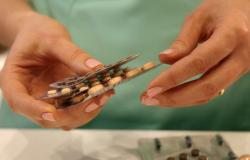Meanwhile, economists promise modest growth for the Latvian economy – an average of 2.5% per year. The Ministry of Finance and the government coalition blame the “low tax morale” of the population for the lack of state budget revenues. In order to increase revenues in the state treasury, another tax increase and full control of taxpayers is being prepared. But that’s not all.
“The number of people in Latvia’s labor market will continue to slowly decrease. However, this does not mean that the contribution of the human capital component to the dynamics of the potential gross domestic product will inevitably be negative,” notes Bank of Latvia economist Oļegs Krasnopjorovs.
Together with an expert from the Bank of Latvia, we explain what needs to be fixed in Latvia for this to happen.
We reduce premature mortality (+0.2%)
Latvia has one of the highest mortality rates among the member states of the European Union. Only Bulgaria and Romania have a higher working-age mortality rate. It increases with age in all countries, but in Latvia the probability of death begins to increase at a very young age and increases faster than in developed EU countries.
For example, in Latvia, the probability of dying at the age of 54 already exceeds the 1% threshold, while in several Central and Northern European countries, this threshold is reached only after the age of 65. The probability of dying in the most economically active age of 30-45 in Latvia is almost four times higher than in Finland, Sweden or Denmark. This is the result of a combination of several factors: relatively low health care funding in the country, inefficient use of this funding, as well as the unhealthy lifestyle of the population itself, especially men – tobacco and alcohol use, insufficient physical activity.
Not all of these factors can be eliminated at once, but by reducing the mortality age coefficients to the level of the most developed EU countries – Sweden, Finland, Ireland, Belgium, the Netherlands, Denmark – Latvia can gain at the expense of more than four thousand survivors. Applying this number of saved lives to the employment age level, we get an additional number of employed people at the level of three thousand people. Such a large number of rescued workers could accelerate the annual growth rate of Latvia’s gross domestic product by 0.2 percentage points per year.
We increase the birth rate (+0.0%)
Contrary to the popular myth, the number of children per woman in Latvia is by no means lower than in most other EU countries.
According to the economist, the birth rate can and should be stimulated, for example, by improving the availability and quality of kindergartens and protecting new mothers from the risk of poverty. However, there is no magic wand that would solve the problem of low birth rate in Latvia. In no other EU country is the number of children per woman even close to 2.1, the level needed to keep the next generation as large as the current one. Low birth rate is an EU-wide problem, and so far no country, not even the rich Nordic countries, has managed to solve it. It is unlikely that Latvia will also be able to overcome this challenge.
Moreover, even a significant increase in the birth rate will not ensure an immediate increase in the rate of economic growth, as it usually takes about 20 years from the birth of a child to the beginning of the working life.
We maintain internal labor reserves (+0.3%)
The historically low number of unemployed in Latvia can create a false impression that the country no longer has internal labor reserves. However, in some EU countries the employment rate is significantly higher than in Latvia, especially among young and middle-aged men.
Experts of the Bank of Latvia point out that the low level of youth employment reflects the low demand for vocational education and its low prestige, the small number of students and the strict regulations that do not promote the employment of young people.
On the other hand, the low employment rate of middle-aged men may reflect the low prevalence of lifelong learning, insufficient digital skills and declining health. Even the health of Latvian youth is worse than that of their peers in EU countries with a high level of employment. As age increases, the differences in the field of health between the population of developed EU countries and Latvia only increase.
If we work with purpose, even with the current state of health among young people, the problem of poor health among middle-aged men will persist from generation to generation, which, according to the economist, would be an unforgivable waste of human capital. If the level of employment in Latvia in each age group was not lower than in Germany, Denmark, the Netherlands, Ireland, Ireland, Sweden and Estonia, the number of employed people in Latvia would be 73 thousand more.
We increase the level of education (+0.2%)
Employees with higher education in Latvia receive 48% more salary than employees with secondary education. A similar premium for higher education, reflecting the positive contribution of education to worker productivity, exists in other countries. The spread of higher education in Latvia has increased significantly since the turn of the century – more rapidly than in most EU countries – and this has been one of the factors that determined economic growth and the convergence of Latvia’s income with EU indicators.
Currently, 43% of Latvia’s economically active population has a higher education, which is a few percentage points less than in EU countries with a high level of employment.
The average level of education of young people entering the labor market is higher than that of the pre-retirement generation, which will leave the labor market in the coming years. Therefore, it is expected that the proportion of economically active population with higher education will continue to gradually increase both in Latvia and in the EU as a whole, reflecting the change of generations. This will determine the increase in labor productivity in the future, and this effect will have a positive effect on the growth of the national economy.
If the proportion of economically active population with higher education in Latvia gradually increases from 43% to 50% within ten years, it will increase the annual growth rate of the gross domestic product by 0.2 percentage points.
Improving the quality of education (+0.5%)
There are obvious significant differences in the results of centralized exams between Latvian secondary schools. Contrary to popular myth, they are largely determined not by the location of the school – urban or rural, but by the size of the school and the salary of the teachers: small schools cannot offer quality education.
School graduates with high results of centralized exams choose certain Latvian universities, but with low results – completely different educational institutions. Thus, the differences in the secondary education stage do not disappear anywhere. Even after graduating from nominally the same study programs in different Latvian universities, the salaries of graduates usually differ several times. The fact that higher education is not equally good everywhere can be sensed from the reports on the accreditation of sectors and programs. Weak universities en masse enroll high school graduates with low centralized exam results, train them at an “easy” level, and these graduates are less successful in the labor market.
In international rankings, Latvian universities are lower than Lithuanian universities and significantly lower than Estonian universities, as well as much lower than Finnish or Swedish regional universities. This year in the “Times Higher Education” ranking, the University of Latvia, ranked highest among Latvian universities, is ahead of only the best Bulgarian university and by 1001-1200. place competes with Croatian and Slovak universities.
By improving the quality of education at each stage of education – basic education, secondary education, professional education, higher education, including master’s and doctoral studies, so that the average salary of graduates increases by 30%, the annual growth rate of the gross domestic product could increase by 0.5 percentage points. This conditional calculation shows the decisive importance of the quality of education in increasing labor productivity and, therefore, economic growth – the potential impact of improving the quality of education on the Latvian economy is much greater than, for example, raising its level.
Improving population health (+0.1%)
In Latvia, employees suffering from chronic diseases, other factors remaining unchanged, have an 8% lower salary than healthy employees. The same applies to other countries – workers with health restrictions have lower labor productivity and, therefore, lower wages.
By gradually improving the health of Latvia’s population to the average level of EU countries with high employment, the annual growth rate of Latvia’s gross domestic product could be increased by 0.1 percentage points. Population health has a much greater impact on economic growth. Improving the state of health is essential both in reducing premature mortality and in activating the internal reserves of the labor market.
We attract highly qualified migrants (+0.6%)
The productivity of employees, or the contribution to the economy, depends on the amount of human capital and physical capital. Growth theory states that the immigrant does not bring physical capital with him. In order for migration not to reduce the gross domestic product per capita in the host country, their human capital must be significantly higher than that of the native population.
It is assumed that 85% of immigrants should be of working age, of which 80% should be economically active and 95% should be employed. Thus, for example, the immigration of 2,000 people will increase the number of employed people in Latvia by 1,300 people or 0.15%. If the elasticity of the gross domestic product in relation to the labor force is 0.67, it means that the growth potential of the economy will increase by 0.1%, summarizes Bank of Latvia economist Oļegs Krasnopjorovs.
Be the first to find out what interesting has happened in Latvia and the world by joining us on the Telegram or Whatsapp channel






